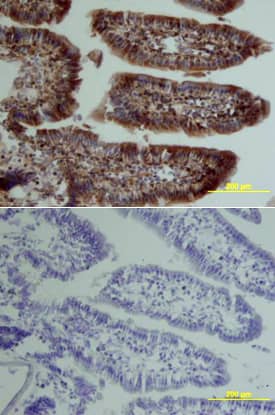Mouse Osteoprotegerin/TNFRSF11B Biotinylated Antibody
R&D Systems, part of Bio-Techne | Catalog # BAF459


Key Product Details
Species Reactivity
Validated:
Cited:
Applications
Validated:
Cited:
Label
Antibody Source
Product Specifications
Immunogen
Gln21-Leu401 (Gln138Arg)
Accession # Q6PI12
Specificity
Clonality
Host
Isotype
Scientific Data Images for Mouse Osteoprotegerin/TNFRSF11B Biotinylated Antibody
Osteoprotegerin/TNFRSF11B in Mouse Intestine.
Osteoprotegerin/TNFRSF11B was detected in perfusion fixed frozen sections of mouse intestine using Goat Anti-Mouse Osteoprotegerin/TNFRSF11B Biotinylated Antigen Affinity-purified Polyclonal Antibody (Catalog # BAF459) at 15 µg/mL overnight at 4 °C. Tissue was stained using the Anti-Goat HRP-DAB Cell & Tissue Staining Kit (brown; Catalog # CTS008) and counterstained with hematoxylin (blue). Lower panel shows a lack of labeling if primary antibodies are omitted and tissue is stained only with secondary antibody followed by incubation with detection reagents. View our protocol for Chromogenic IHC Staining of Frozen Tissue Sections.Applications for Mouse Osteoprotegerin/TNFRSF11B Biotinylated Antibody
Immunohistochemistry
Sample: Perfusion fixed frozen sections of mouse intestine
Western Blot
Sample: Recombinant Mouse Osteoprotegerin/TNFRSF11B Fc Chimera (Catalog # 459-MO)
Mouse Osteoprotegerin/TNFRSF11B Sandwich Immunoassay
Formulation, Preparation, and Storage
Purification
Reconstitution
Formulation
Shipping
Stability & Storage
- 12 months from date of receipt, -20 to -70 °C as supplied.
- 1 month, 2 to 8 °C under sterile conditions after reconstitution.
- 6 months, -20 to -70 °C under sterile conditions after reconstitution.
Background: Osteoprotegerin/TNFRSF11B
Osteoprotegerin (OPG)/Osteoclastogenesis Inhibitory Factor (OCIF) is member of the tumor necrosis factor receptor superfamily that lacks any apparent cell‑association motifs and exists as a soluble secreted protein. In the new TNF superfamily nomenclature, OPG is referred to as TNFRSF11B. OPG was originally isolated by sequence homology as a TNF receptor family protein during a fetal rat intestine cDNA-sequencing project and subsequently shown to be involved in the regulation of bone density. OCIF was initially purified from the conditioned medium of human embryonic fibroblasts based on its ability to inhibit osteoclast development. Comparison of the amino-acid sequences of human OPG and OCIF proteins revealed their identity. The amino-terminal half of OPG contains four cysteine-rich repeats characteristic of TNF receptor family members. The carboxy-terminal of OPG/OCIF was found to contain two death domain homologous regions in tandem. Human and mouse OPG share approximately 84% and 94% amino acid sequence identity, respectively, with the rat OPG. Natural OPG/OCIF has been found to exist predominantly as disulfide-linked dimers. Two TNF superfamily ligands, including the membrane proteins OPG ligand/TRANCE (tumor necrosis factor‑related activation-induced cytokine)/ODF (osteoclast differentiation factor)/RANKL (receptor activator of NF-kappaB ligand) and TRAIL (TNF-related apoptosis‑inducing ligand)/APO-2 ligand, have been shown to be the cellular ligands for OPG/OCIF. Each of these ligands has been shown to interact with additional TNF receptor family members, including RANK (with TRANCE) and TRAIL receptors 1‑4 (with TRAIL). The roles of these receptor-ligands in osteoclastogenesis, apoptosis and in the immune system remains to be elucidated.
References
- Lacey, D.L. et al. (1998) Cell 93:165.
- Emery, J.G. et al. (1998) J. Biol. Chem. 273:14363.
- Yasuda, H. et al. (1998) Proc. Natl. Acad. Sci. USA 95:3597.
Alternate Names
Gene Symbol
UniProt
Additional Osteoprotegerin/TNFRSF11B Products
Product Documents for Mouse Osteoprotegerin/TNFRSF11B Biotinylated Antibody
Product Specific Notices for Mouse Osteoprotegerin/TNFRSF11B Biotinylated Antibody
For research use only